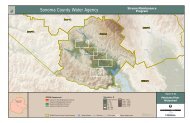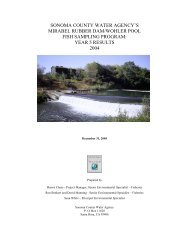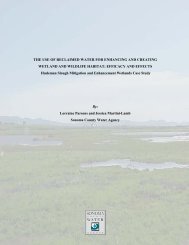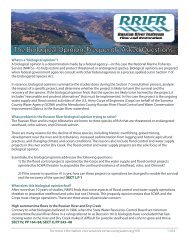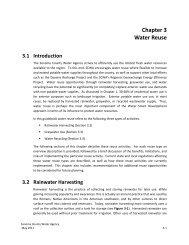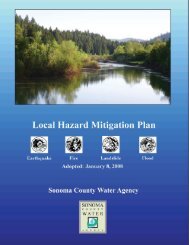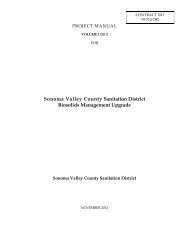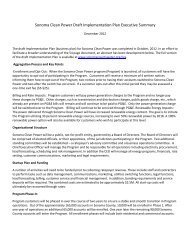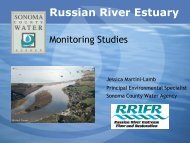Hydrography of the Russian River Estuary - Sonoma County Water ...
Hydrography of the Russian River Estuary - Sonoma County Water ...
Hydrography of the Russian River Estuary - Sonoma County Water ...
Create successful ePaper yourself
Turn your PDF publications into a flip-book with our unique Google optimized e-Paper software.
During <strong>the</strong> late-October closure, stability at Freezeout Creek was higher than previously<br />
observed as a result <strong>of</strong> a higher salt mass in <strong>the</strong> estuary. This was probably due to a<br />
large wave event at <strong>the</strong> time <strong>of</strong> closure. Following closure, this salt mass intrudes<br />
landward, introducing more sub-pycnocline to Freezeout Creek and thus enhanced<br />
stability.<br />
3.5 – Salt and oxygen mass budgets<br />
3.5.1 – Salt budget for estuary<br />
Given that salt is nei<strong>the</strong>r created nor destroyed on <strong>the</strong> time scale <strong>of</strong> interest in this<br />
study, <strong>the</strong> total mass <strong>of</strong> salt contained in <strong>the</strong> estuary is conserved in <strong>the</strong> absence <strong>of</strong><br />
inflows or outflows <strong>of</strong> saline water. It is unaffected by processes, such as river inflow,<br />
evaporation, mixing, or density-driven exchange flows. Thus one can learn much about<br />
<strong>the</strong> estuary by tracking <strong>the</strong> salt mass. A gain <strong>of</strong> salt implies a gain <strong>of</strong> saline water (i.e.,<br />
seawater) and a loss <strong>of</strong> salt implies a loss <strong>of</strong> saline waters from <strong>the</strong> estuary. Of specific<br />
interest is <strong>the</strong> possible loss <strong>of</strong> estuary water via seepage through <strong>the</strong> sand barrier, as<br />
addressed through a water budget (Section 3.1).<br />
To calculate <strong>the</strong> mass <strong>of</strong> salt from CTD pr<strong>of</strong>ile data, <strong>the</strong> estuary was divided into<br />
segments (Figure 3.37), and each segment was divided into incremental volumes in <strong>the</strong><br />
vertical direction. These incremental volumes were multiplied by CTD measurements <strong>of</strong><br />
salinity at corresponding depths and summed up over <strong>the</strong> total depth to obtain a salt<br />
mass for each segment for each time a CTD pr<strong>of</strong>ile was obtained. The total mass <strong>of</strong> salt<br />
in <strong>the</strong> estuary is obtained from a sum <strong>of</strong> all segments. For this analysis, <strong>the</strong> upper<br />
boundary is taken as Freezeout Creek, since <strong>the</strong> upstream pool at Moscow Bridge<br />
received only negligible amounts <strong>of</strong> salt during <strong>the</strong> monitoring period.<br />
55





